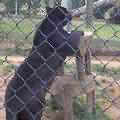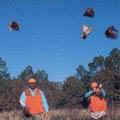憐憫心,有時候是設身處地為人著想的必要能力。
真正平安喜樂的獲得,來自他人也同樣的平安喜樂,這是一種常識。 ── 美國牧師作家福萊瑞德.畢克納
暴力的原因絕非無知,而是自私使然。
唯有尊重可以抑制暴力……對環境及人類生命的尊重。 ──美國牧師作家威廉史龍柯芬
暴力,是無能最後的藉口。
──科幻小說作家以薩克‧艾斯摩
 除了傷害孩童外,沒有比將謀殺動物當作運動更懦弱的行為了。躲在樹下,用火力強大的來福槍,射殺那在350碼外健康的麋鹿鳥獸,這樣的行為怎麼會被稱做「運動」呢?
除了傷害孩童外,沒有比將謀殺動物當作運動更懦弱的行為了。躲在樹下,用火力強大的來福槍,射殺那在350碼外健康的麋鹿鳥獸,這樣的行為怎麼會被稱做「運動」呢?
然而,有些獵人更為懦弱而缺德,他們付費給狩獵區的擁有者,即有權利在幾碼、甚至幾呎內開槍射殺動物,而通常這些動物都還在獸欄裡。像這樣與自然界徹底脫離、危害我們世界的例子,可說莫此為甚。
根據2002年3月11日出刊的「時代雜誌」指出,美國境內現約有2,000個狩獵保留區,光是德州就有500個。大部分的獵場都對顧客提出保證,如果沒獵到任何獵物就不需付費。而為了維護這樣的承諾,傳統的狩獵規則就常常被擱在一旁。
獵場的動物已經習慣接觸人類,有些還已經被訓練成,一聽到飼料桶的聲響,就會主動靠攏過來;有些動物被囚禁在小型場地裡,這樣環境使牠們無法藏匿太久;許多動物更是在離開籠子之前就已被殺害。
獵場經營者透過這種不道德的經營手段而獲得大筆財富。如果是外來種的動物,像努比亞山羊、阿拉伯羚羊、犀牛、斑馬或老虎等外來動物,更可索價2萬美元以上。
即便同是獵人,也有人反對這樣的活動。住在佛州湖泊市的派瑞‧阿諾德,從七歲就開始從事授獵活動,他向「時代雜誌」表示,他不贊同射殺獸欄內動物的狩獵方式。他說:「他們這樣做,並不是在打獵,那簡直與屠殺無異。」
我曾看過一段由美國人道協會(HSUS)所提供的影片:一隻被取掉利爪的黑豹,從小貨車後方的籠子被釋放出來,狂吠的狗群緊追在黑豹後面,牠躲進貨車下方,因恐懼而發抖著。而那個付錢買『狩獵』的人,便輕舉他那火力強大的來福槍,跪在車旁,向車下那隻恐懼畏縮的動物近距離開槍。這部影片真是我所看過人類殘暴對待動物的有行徑中,最可悲的例子。
無論是獸欄狩獵或一般的狩獵,被獵來當裝飾品的動物,會比被宰殺來食用的動物受到更多痛苦。獵人既然是要一顆完整的頭來做成裝飾品,所以他們不會射擊動物的頭部讓牠迅速死亡,相反的,他們會用子彈或弓箭對準動物的身體再射擊。結果通常是那些受傷的動物就在驚慌當中,蹣跚地跛行著,直到被連續射擊致死。這些動物的死亡過程多是冗長而痛苦的,但獵人在展現狩獵紀念品時,卻吹噓著自己的勇氣與膽量。
在美國,這樣的行為幾乎是每天不斷地重覆發生。但是,這些貪婪而無人性的獵場老板,究竟是從哪裡得來這些動物的?
您將會為所得到的答案震驚,特別是如果您曾經帶孩子去動物園看他們所喜愛的動物。
 在美國約有2,500個持有執照的動物展示場,且有許多豢養的動物都會繁殖。有些統計指出,若包括沒有執照場所,則約有1萬5千個動物展示場。此外,許多動物園都有成功的繁殖計畫,社會大眾也捐款支持動物園,進行繁殖稀有的、甚至是瀕臨絕種的動物。
在美國約有2,500個持有執照的動物展示場,且有許多豢養的動物都會繁殖。有些統計指出,若包括沒有執照場所,則約有1萬5千個動物展示場。此外,許多動物園都有成功的繁殖計畫,社會大眾也捐款支持動物園,進行繁殖稀有的、甚至是瀕臨絕種的動物。
然而大眾並不知道,動物園往往沒有足夠個空間及資源,去照料這些成功繁殖出來的動物。
還有,您可能認為這些計畫所繁殖的動物,應該會回歸自然,來增加這些物種的數量。不幸的是,大部分的時候,動物園沒有經費可以實行那些高尚的目標,因此造成園內的動物數量過剩。同時動物園也讓那些非屬瀕臨絕種的野生動物物種進行繁殖,造成長頸鹿、猴子與犀牛的數量,超過動物園所能收容與餵養的限度。
新加坡動物園便直接承認,就算是那些飼養在籠內的瀕臨絕種動物,牠們被野放的機會也都不大。新加坡動物園網站上的官方聲明寫道:「有許多原因使得這些在封閉環境下繁殖出來的瀕臨絕種動物,不適合野放,但可以與其他動物園做交換。」他們聲稱,這麼做可以減少動物園對真正野生動物的需求數目。
一些有合法登記且知名的動物園會把過剩的動物賣給掮客(交易仲介商)。就算動物園本身即為反對獸欄狩獵團體「美國動物園與水族館協會」的成員,園方也不去追問掮客究竟會把動物賣到哪裡去。許多動物最後都成了獸欄狩獵活動中的獵物。
更不用說那數量眾多的寵物園、非正規的動物園、或小型展示館,他們更沒有義務或是權責方面的壓力,去遵守任何規則或指導方針。
「人道協會」的報告指出,德州的聖安東尼奧動物園公開販售園內的動物,而在該動物園的董事會成員當中,甚至有人是獵場的擁有者。在1994年,該協會曾有報導指出,聖安東尼奧動物園董事會成員貝蒂‧凱斯洛跟她的丈夫羅柏特,擁有德州的奧漢獵場(Auerhahn Ranch),他們直接向動物園購買外來種動物達數年之久。
醫生、律師以及其他各行各業的人士,離開他們位在郊區的住家,來此度過週末的殺戮饗宴,索價高昂的利益遊說者就在這些狩獵區裡取悅著政客。「野生動物保護網」表示:「獸欄狩獵區已開始變得像高爾夫球場一樣,成了施弄政商手腕的最佳場所。」其報告指出,美國前總統喬治‧布希1988年的選舉慶功宴,便是在德州比威爾附近的Lazy F農場裡舉行的。
 對於人們批評這每年一次狩獵活動,布希不久後便回應說:『這些不是動物,他們是野生鵪鶉。』很顯然的,布希先生從未唸過生物,且對何謂「野生」,有著不尋常的定義。他所射殺的鳥,是被囚禁在籠裡的鳥,由人類餵養長大。
對於人們批評這每年一次狩獵活動,布希不久後便回應說:『這些不是動物,他們是野生鵪鶉。』很顯然的,布希先生從未唸過生物,且對何謂「野生」,有著不尋常的定義。他所射殺的鳥,是被囚禁在籠裡的鳥,由人類餵養長大。
柯林頓總統在任期間也曾在狩獵區打獵過。「野生動物保護網」指出:在1993年的聖誕節過後兩天,柯林頓總統在馬里蘭州的狩獵區內射殺了一隻豢養的綠頭鴨。這個獵場為利益遊說者約翰W.泰德二世所擁有。他在一個鼓吹狩獵的政治行動團體DUCPAC擔任財務長,這個團體在選舉期間捐了超過3萬5千美元給政黨候選人。
「聖荷西水星新聞報」在1999年時,曾有過一系列關於動物園動物數目過剩現象的報導,其中指出,世界知名的聖地牙哥動物園將該園內33%的過剩動物,透過販售、貸借、交易或捐贈的管道,轉給動物交易商、拍賣會、比賽場或獵場、不具名的個人,或是未經核准的動物園,這些場所的擁有者,大量的交易外來種動物。
要重建與自然界的連結,消除社會及環境上諸多不健全的層面,最大的障礙可能在於我們平時對世界運轉方式的假設。動物園並不是一個仁慈的教育場所,它無法提供我們機會去觀察生活在自然棲地的動物。動物園是種生意行為,動物的生活在此被剝削,而我們的文化則更加深了這種剝削。
有時候為了省錢,生病的動物就被忽視了,而管理動物者往往是不合格的人選,這些人從搬工一路爬昇到管理外來種動物的職位。這些動物被展示在最不自然的狀況下,一個習慣於在幾百平方哩範圍大的區域活動的動物,怎麼可能對一個兩百英呎長的小空間感到滿意?
而這些動物園及展覽動物的單位,好像還覺得自己不夠壞似的;我們現在還發現他們提供過剩動物給獸欄狩獵場,也許您的孩子在幾個禮拜前還看過這些動物,並為牠開懷不已呢。
在我們未能停止以奴役或展示品的態度,來看待這些有思想、有感覺且有判斷力的生命體之前,我們不會有機會消弭我們對彼此以及這個世界的疏離感。
在我們結束以血腥的殺戮動物當休閒活動、並停止無謂的獸欄狩獵之前,誰才是地球上最低等的生物,無庸置疑。
【參考資料】
- 去美國人道協會網站,看看你能為「中止獸欄狩獵」做些什麼,並隨時追蹤相關法令的最新消息:http://www.hsus.org/ace/12090
- 閱讀「美國人道協會」有關動物園的報導:http://www.hsus.org/ace/12095
- 對這些不人道的「獸欄狩獵」了解更多: http://www.wildlifeprotection.net/CannedHunt/cannedhuntindex.html
- 閱讀動物基金會關於「獸欄狩獵」的報告: http://fund.org/library/documentViewer.asp?ID=338&table=documents
- 閱讀與聖地牙哥動物園非法交易野生動物的報導:http://www.bornfree.org.uk/news002.htm
- 拜訪新加坡動物園的網站:http://www.zoo.com.sg/openzoo/conser/c-conser.htm
- 看看那些在澳洲、非洲、亞洲各地動物園裡過剩的動物:http://www.seaza.org/animal_exchange/animal_exchange.htm
- 拜訪廢除動物園聯盟的網站:http://www.noazark.org/Company/philosphy.htm ,了解他們的「動物園神話論」http://www.noazark.org/myths/Index.htm
- 閱讀有關「獸欄狩獵」的報告:http://www.enkosini.com/TrophyHunting.htm
- 找出誰是你的國會代表,且以電子郵件告知他們,必須立法中止在全美50州的封閉性狩獵。如果你知道你的郵遞區號,你可在以下這個網址查詢:http://www.visi.com/juan/congress/ziptoit.html
- 與你的州代表聯絡,並堅持他們應該支持「禁止獸欄狩獵」的條款。
"Compassion is sometimes the fatal capacity
for feeling what it is like to live inside somebody else's skin.
It is the knowledge that there can never really be
any peace and joy for me
until there is peace and joy finally for you too."
-- Frederick Buechner
"The cause of violence is not ignorance.
It is self-interest. ...
Only reverence can restrain violence --
reverence for human life and the environment."
-- William Sloan Coffin, Jr.
"Violence is the last refuge of the incompetent."
-- Isaac Asimov
Besides harming children, there is no more cowardly an act than murdering an animal for sport. What could possible be "sporting" about shooting a healthy elk, deer, bird, or prairie dog from 350 yards away with a high-powered rifle while hiding in a tree?
Even more cowardly and obscene, though, may be the hunters who pay a fee to game preserve owners for the right to kill an animal from a few yards or even a few feet away, often while the animal is in a cage. There may be no greater example of the profound disconnection from the natural world that is plaguing our world.
According to “Time” magazine’s March 11, 2002 issue, as many as 2,000 hunting preserves may exist in the U.S. with 500 in Texas alone. Most offer a guarantee that if you don’t kill something, you don’t pay. In order to offer such a promise, traditional rules of sport hunting are usually suspended.
The animals at these ranges are made accustomed to human contact and some are trained to come to the sound of a rattling food bucket. Some are confined to small areas where they can’t hide for very long. And many don’t even make it out of their cages before being murdered.
There is good money in this obscene practice for the range operators. Exotic animals like the Nubian ibex, the Arabian Oryx, rhinoceros, zebra or tigers can command $20,000 or more.
Even some hunters object to the practice. Perry Arnold of Lake City, Florida, who has been hunting since he was seven years old, told “Time,” he disapproves of these canned hunts. “What they got going on now, that ain’t hunting. That’s a slaughter.”
I have seen video footage, obtained by the Humane Society of the United States (HSUS), of a black leopard whose claws had been removed that was released from a cage in the back of a pickup truck. It was chased by barking dogs and hid, terrified and trembling, beneath the truck. The hunter who had paid for this “hunt,” got on his knees with his high powered rifle just feet from the truck and shot the frightened, cowering animal. It was the most pathetic example of how brutal a human can be towards an animal that I had ever seen.
Animals hunted for trophies, whether they are killed in canned hunts or in regular sport hunting, suffer much more than any animal killed for food. Since the hunter wants an intact head for display, they will not kill the animal quickly by shooting it in the head. Instead, they use arrows or bullets aimed at the body of the animal, usually resulting in a wounded animal staggering, limping, and panicked while the killer continues to shoot. Death is often slow and painful. But the hunter has his or her trophy head to show friends and to brag about his bravery and courage in the fight.
Acts like this are repeated every day around the nation. But where are these greedy, soulless preserve owners getting these animals?
You will be shocked and surprised at the answer, especially if you have taken your children to the local zoo to see their favorite beloved animal.
There are 2,500 licensed animal exhibitors in the U.S. and many of the animals in captivity will breed. Some estimates say that when you count the unlicensed ones, there are over 15,000 animal exhibitors. Also, many zoos have successful breeding programs that get public donations to support their fforts to repopulate depleted, even endangered species.
Well, what the public doesn’t hear about is that when these breeding programs are successful, they often result in more animals than the zoo can care for with limited space and resources.
But wait a minute! You probably thought that the resulting animals from these programs would be returned to the wild to repopulate the species. Unfortunately, often money does not exist to carry out those lofty aims and the animals become surplus. Animals that are not endangered in the wild will breed as well, resulting in more giraffes, monkeys, and rhinos than zoos can house and feed.
The Singapore Zoo freely admits that even endangered species bred in captivity have little chance of being returned to the wild. At the zoo's website, officials state, “While for many reasons, it may not be possible to reintroduce most captive-bred endangered animals into the wild, such animals can be used in exchange programmes among zoos.” They claim that this results in fewer animals having to be taken from the wild.
Legitimate, well known zoos sell surplus animals to brokers. Even zoos that are members of the American Zoo and Aquarium Association, which condemns canned hunts, will not ask their brokers where they intend to sell the animals. Many wind up in canned hunts.
The thousands of petting zoos, roadside zoos, and smaller exhibitors have no reason to adhere to any rules or guidelines.
The Humane Society reports that the San Antonio Zoo in Texas sold its animals openly and even included owners of canned hunting facilities on the zoo's board of directors. In 1994, HSUS reported that San Antonio Zoological Society board member Betty Kelso and her husband Robert owned the Auerhahn Ranch in Texas and purchased exotic animals directly from the zoo for years.
Doctors, lawyers and professionals from all walks of life leave the suburbs for a weekend killing spree, and high priced lobbyists entertain politicians on shooting preserves. The Wildlife Protection Network says, “Canned hunting preserves have begun to rival golf courses as favorite landscapes [for] wheeling and dealing.” They report that former President George Bush celebrated his victory after the 1988 presidential election at the Lazy F Ranch near Beeville, Texas.
"These aren't animals, these are wild quail," he later said to criticism of his yearly hunt. Bush apparently never studied biology, and has an odd definition of "wild." The birds he shot were captive birds that were hand fed and raised in pens.
President Bill Clinton hunted on shooting preserves during his presidency. The Wildlife Protection Network says, “Two days after Christmas in 1993, President Clinton killed a captive bred mallard duck on a Maryland shooting preserve owned by lobbyist John W. Tieder, Jr. Tieder is the treasurer of DUCPAC, a pro-hunting political action committee that has given over $35,000 in campaign contributions to political candidates.”
The “San Jose Mercury News,” in a 1999 series of articles on surplus zoo animals, reported that the world famous San Diego Zoo has "sold, loaned, traded or donated 33 percent of its surplus animals to dealers, auctions, game or hunting ranches, unidentified private individuals or unaccredited zoos whose owners deal heavily in the exotic animal trade."
There may be no greater obstacle to reestablishing a connection with the natural world and eliminating our many social and environmental dysfunctions than the assumptions we make every day about how the world works. Zoos are not benign facilities providing educational viewing of animals in their natural habitats. They are businesses where animals are exploited yet again in our culture.
Sick animals are sometimes ignored to save money and zookeepers are often unskilled people who have worked their way up from jobs on the loading dock to supervisory positions managing the lives of exotic animals. The animals are on display in the most unnatural of conditions. How can an animal who is used to roaming an area of hundreds of square miles be content in a 200 foot long enclosure?
And as if the practices of zoos and animal exhibitors are not bad enough on their own, now we learn that they have been supplying the obscene canned hunt trade with surplus animals that your children may have laughed at just a few weeks ago.
Until we stop treating animals that have proven time and time again that they are thinking, feeling, reasoning beings as slaves and exhibits, we will have no chance of healing the isolation we feel from the world and from each other.
And until we end the brutal killing of animals for sport and stop these senseless canned hunts, there will be no question about who represents the lowest form of life on Earth.
RESOURCES
1. See a list of things you can do to end canned hunts from HSUS and keep track of current legislation at: http://www.hsus.org/ace/12090
2. See more issues about zoos from HSUS at: http://www.hsus.org/ace/12095
3. Learn more about these obscene canned hunts at:http://www.wildlifeprotection.net/CannedHunt/cannedhuntindex.html
4. See a Fund for Animals report on canned hunts at:http://fund.org/library/documentViewer.asp?ID=338&table=documents
5. Read about case of illegal wildlife trade at the San Diego Zoo at:http://www.bornfree.org.uk/news002.htm
6. See the Singapore Zoo website at: http://www.zoo.com.sg/openzoo/conse/c-conser.htm
7. See some surplus animal lists from Australian, African, and Asian zoos at:http://www.seaza.org/animal_exchange/animal_exchange.htm
8. See the website of the National Organization to Abolish Zoos at:http://www.noazark.org/Company/philosphy.htm See their list of Zoo Myths at:http://www.noazark.org/myths/Index.htm
9. Read an account of a canned hunt at:http://www.enkosini.com/TrophyHunting.htm
10. Find out who your Congressional representatives are and e-mail them. Tell them that they must enact legislation banning canned hunts in all 50 states. If you know your Zip code, you can find them at:http://www.visi.com/juan/congress/ziptoit.html
11. Contact your state representatives and insist that they sponsor laws banning canned hunts.
{Jackie Alan Giuliano, Ph.D. is a writer and teacher in Seattle. He can be found wondering what to tell his son when he is old enough to want to go to the zoo. Please send your thoughts, comments, and visions to him at:jackie@healingourworld.com and visit his website at:http://www.healingourworld.com}
※ 全文及圖片詳見:ENS






